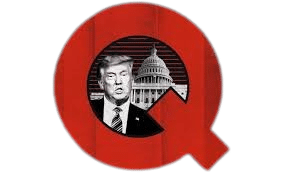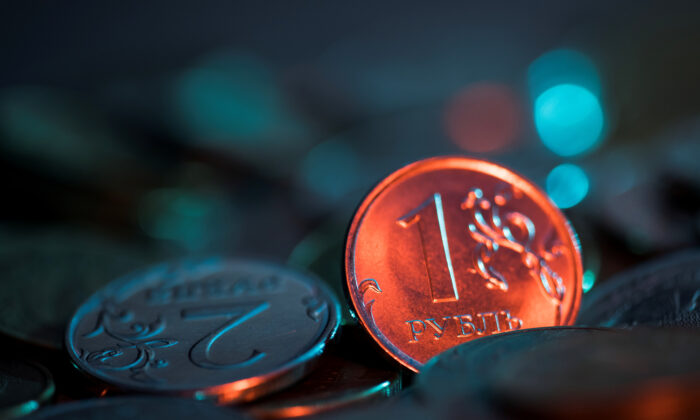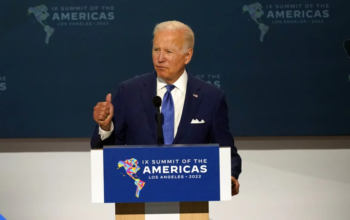The Russian ruble has turned into the top-performing currency in global financial markets, despite Moscow facing a bombardment of crippling economic sanctions and financial restrictions.
Year-to-date, the ruble has strengthened by about 14 percent against the U.S. dollar. By comparison, the U.S. Dollar Index (DXY), which gauges the greenback against a basket of currencies, has advanced by roughly 6 percent.
Following Russia’s invasion of Ukraine, the currency had cratered to pennies on the dollar. But after a series of fiscal and monetary policy interventions, the ruble recovered and is now performing better than the Brazilian real, Uruguayan peso, and the Mexican peso this year.
Since mid-March, when it bottomed out against the U.S. dollar, the ruble has appreciated by more than 115 percent.
But the ruble’s rally took a breather on May 26, after the country’s central bank pulled the trigger on its third cut to interest rates in a little more than a month.
The Central Bank of Russia reduced its benchmark rate from 14 percent to 11 percent, making it less attractive to hold rubles. The decision was higher than economists’ expectations of 2 percentage points.
Overall, the institution has executed 900 basis points worth of easing since the beginning of April. Elvira Nabiullina, head of the central bank, revealed that she thinks more rate cuts could happen at future meetings, saying that “the coming quarters won’t be easy.”
Moscow has seen encouraging signs in the latest inflation data, enabling the institution to unwind its aggressive policy tightening.
The monthly consumer inflation rate rose by 1.6 percent in April, down from the 7.6 percent month-over-month spike in March. The producer price index (PPI) climbed by 6.3 percent month-over-month, compared to the 5.9 percent increase in March.
Officials have also been trying to decelerate the ruble’s immense gains by loosening capital controls, but these efforts have so far been unable to achieve this objective.
At the beginning of the military conflict, Russia undertook a series of measures to support the ruble, including capital controls that prevented asset sales, gold purchases after a two-year hiatus, and forcing companies to buy rubles. Now that the ruble is one of the top-performing currencies, Russian officials might have done too much to stabilize the currency.
Typically, a stronger currency is good for an economy, since it can help fight inflation and enhance the nation’s purchasing power, making it cheaper to purchase foreign goods. However, because Russia is mostly barred from international commerce, Moscow can hardly buy anything from advanced economies. Market analysts are unsure if this strategy will be enough to slow down the ruble’s acceleration, since much of the currency’s movement is now dependent on the trade balance.
A rising ruble can also put a dent in the Kremlin’s budget, trimming the value of its oil-and-gas tax revenues that are priced in U.S. dollars. Russia is enduring growing financial pressures at home as well, such as the ballooning costs of the war in Ukraine and increasingly expensive social programs.
Although the international community has censured President Vladimir Putin and his government, Moscow is still supplying several foreign markets with its energy products. In April, Russian crude oil exports rose by 2 percent, totaling about 4.88 million barrels per day. This year, Russia has been bolstering trade with China and India in response to the European Union’s oil embargo, which experts project could decrease the country’s exports by about 20 percent.
“But unless natural gas prices plunge and/or there are secondary sanctions on Russian oil, this won’t cause major pain for Russia’s economy immediately,” Edward Gardner, a commodities economist at Capital Economics, wrote in a research note.
Global financial markets will be monitoring Russia’s debt obligations. Now that the U.S. government has closed a loophole in sanctions that enabled foreign payments in dollars, Moscow could once again be on the brink of default. The Russian government will now service its debt in rubles, which would violate the terms of bond agreements.
Coupon payments for the 2026 dollar bond are due on May 27. Payment in rubles would automatically breach the conditions of the financial deal, initiating a 30-day grace period before Russia hits a default.
However, Finance Minister Anton Siluanov said in a statement to Bloomberg that this is an “artificial situation created by an unfriendly nation,” noting that Moscow has the funds “and the willingness to pay.”
A Peek at the End of 2022
Looking ahead, ING Russian economist Dmitry Dolgin forecasts that the USD/RUB currency pair will finish the year at about 75 as Europe’s total or partial embargo on oil will hit the economy in the second half.
“At the same time, Russian resident demand for FX and imports start to stabilise,” the Dutch bank said in a research note. “Before then, however, and because USD/RUB is mainly being driven by Russian commercial flows, a large rate cut may not send the ruble too much lower in the near term.”
It might be more challenging to determine the ruble’s outlook since fewer investors are actively trading the ruble. In recent months, foreign financial institutions have ceased offering electronic quotes to clients to buy and sell the currency.
Nevertheless, the Russian economy has recovered from the initial shock that occurred in February and March, and according to Goldman Sachs economist Clemens Grafe, “concerns about financial stability are fading, the RUB has strengthened back to early 2020 levels.”
The broader economy could still experience pain for the rest of the year, with the country’s gross domestic product expected to contract by between 10 percent and 12 percent in 2022. This would be the largest decline in economic activity since the 2008–09 global recession.
Source: The Epoch Times




